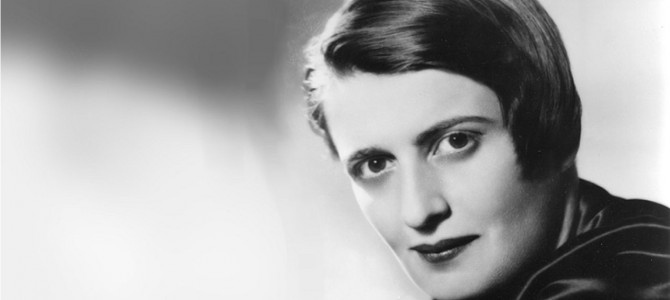New American Library has just published a “lost” Ayn Rand novel, Ideal.

Except that it wasn’t really “lost.” That’s a bit of publisher’s hype. Ideal was written by Ayn Rand as a novelette in 1934, then later adapted as a play, which is a better fit to its episodic structure. That’s the version I read many years ago as part of a 1986 collection of Ayn Rand’s early, unpublished works. So the story is not exactly new, though the differences between the two versions, which are both included in the new volume, are likely to be of interest to die-hard fans.
But the reception for the new book is already turning out to be an ironically fitting tribute to its theme.
The story follows a Garboesque Hollywood actress, Kay Gonda, who has been implicated in a murder and shows up suddenly on the doorsteps of a varied collection of her fans—a playboy, a family man, a socialist, a preacher, and so on—seeking sanctuary. Each of them has written fan mail declaring her to be a representative of the ideal. She puts them to the test, and one after another they each come up with excuses to betray their ideal.
It is an interesting meditation on the nature of idealism, and in a way it is her answer to the novelist who influenced her, Victor Hugo. She would later write in praise of Hugo, naming the theme of his work: “It is not any specific code of values that concerns him…but the wider abstraction: man’s loyalty to values, whatever any particular man’s values might be…. The emphasis he projects is not: ‘What great values men are fighting for!’ but: ‘What greatness men are capable of, when they fight for their values!'” She wrote this in her introduction to an edition of Hugo’s novel Ninety-Three, but the modern American audience is more likely to think of Les Misérables, in which all of the most interesting conflicts are between heroes with clashing views of the world.
So you can see why she would take up this same issue, dedication to values and ideals, in her own work. But in Ideal, she inverts Hugo’s premise in an intriguing way. It is the moral and philosophical values men hold that keeps undermining their dedication to the ideal. They keep sacrificing what is most exalted in them to some “higher cause” dictated by their philosophical loyalties—to the socialist revolution, to the religious conversion of the masses, and so on. In effect, what Ayn Rand is saying to Victor Hugo is that men cannot be great no matter which values they pursue, because some moral systems undermine the very thing in them that makes greatness possible.
What she is working toward, but never fully expresses in Ideal, is the theme that would be central to the novel that made her famous, The Fountainhead: the idea that individualism is the wellspring of human integrity and achievement, and that any creed that denies the value of the individual will lead to the destruction of the human spirit.
But she wasn’t quite there yet, and while Kay Gonda does eventually find someone who will not betray the ideal, this character is only a quick sketch and seems almost confused about what exactly he does stand for—even as he gives it his fullest, unflinching devotion in a wrenching climactic scene. Ayn Rand once said about her 1936 novel We the Living—a semi-autobiographical story about an idealistic young woman struggling to survive under the early years of Soviet tyranny—that she was not yet ready to write about the ideal man, but she was ready to write about a woman’s reaction to the ideal man. In Ideal, she was not yet ready to write about what the ideal actually is, but she was ready to write about how people respond to it.
Which brings us, with almost poetic symmetry, to a review of Ideal in Time magazine by Anne Heller, the author of a moderately inaccurate 2009 biography of Ayn Rand. The review is behind a paywall, which is odd because I can’t think of a reason why anyone would pay to read Time. But a version is up on Heller’s own site, so we can go from that. Heller reviews Ideal by using it to argue that idealism is dangerous. Isn’t that perfect?
In fact, she concludes by projecting onto Ayn Rand responsibility for the crimes of two recent mass shooters: “reading Ideal today, I can’t help glimpsing Dylann Roof, James Holmes, and all their murderous kind in the undoubting fanaticism of Johnny Dawes” from Ideal. Dylann Roof you may recognize as the racist who recently shot up a church in Charleston, South Carolina. Holmes shot up a theater in Aurora, Colorado, a few years ago. (Newsbusters notes that Holmes was edited out of the version published in Time, presumably because one of the editors realized that he was not any kind of fanatic but killed because the voices in his head told him to.)
This spectacular claim—that Ayn Rand’s impassioned idealism is a species of murderous fanaticism—comes a bit out of the blue, but Heller hangs it on a rather selective discussion of notes Ayn Rand made in her journals in 1928 about a murderer named William Hickman. Hickman’s defiance after his capture, and the reaction against him—a reaction she saw as being less about the evil of his crime than about his refusal to conform to social convention—caught her attention and caused her to work on a fictionalized version called The Little Street, a project she worked on for a while and then dropped.
Hickman has been long forgotten everywhere else, but he will live forever in the minds of Ayn Rand’s detractors, because they can now cite her notes on his case as proof that she was an admirer of serial killers and probably a psychopath herself, which means that they can now safely ignore every argument she ever made. Isn’t that convenient?
In fact, this is only proof that writers should burn their notes before they die, because inevitably some idiot is going to come along and use your half-though-out ramblings as proof of what you really believed, in contradiction to the thousands of pages of meticulously edited work that you actually published. In this case, if we want to know what fascinated Ayn Rand about the case of a notorious criminal, we can look at what she said in her introduction to one of the works that eventually came out of the themes she first explored in The Little Street: her 1933 play “Night of January 16th,” which enjoyed some success on Broadway and nationwide. This play revolves around a character who is not a murderer but a con artist, who has disappeared after the collapse of a spectacular financial fraud. In her introduction to a 1968 edition of the play, she wrote:
Night of January 16th is not a philosophical, but a sense-of-life play…. This means that its events are not to be taken literally; they dramatize certain fundamental psychological characteristics, deliberately isolated and emphasized in order to convey a single abstraction: the characters’ attitude toward life…. The events feature the confrontation of two extremes, two opposite ways of facing existence: passionate self-assertiveness, self-confidence, ambition, audacity, independence—versus conventionality, servility, envy, hatred, power-lust.
I do not think, nor did I think it when I wrote this play, that a swindler is a heroic character or that a respectable banker is a villain. But for the purpose of dramatizing the conflict of independence versus conformity, a criminal—a social outcast—can be an eloquent symbol. This, incidentally, is the reason of the profound appeal of the “noble crook” in fiction. He is the symbol of the rebel as such, regardless of the kind of society he rebels against.
For more details, ask Cary Grant—or Pierce Brosnan—or Matt Bomer.
So it turns out that characters in literature are not necessarily supposed to be taken literally but can be symbolic. Who knew? So much for William Hickman and The Little Street and Ayn Rand supposedly being a fan of psychopaths.
(Incidentally, one of the real howlers in Heller’s review is her description of “Night of January 16th” as a “creaky courtroom drama.” In fact, it was tremendously creative, which was the reason for its success. Ayn Rand started with the idea that the courtroom’s jury would be drawn from members of the audience, with two endings written to cover the two different outcomes. More important, though, is that she deliberately wrote the play with the evidence equally balanced, so that the audience-jury decides based on who they want to believe. The verdict isn’t really about the guilt or innocence of the protagonist. It’s about the values and “sense of life” of the audience. That’s a twist only Ayn Rand could have come up with: you judge the defendant, but she also judges you.)
The use to which Heller puts all of this nonsense is to claim that “Rand hated ordinary people with a vengeance.” If you’re a fan of Ayn Rand’s novels, you probably burst out laughing just now, because it’s so ridiculously untrue, and you’re thinking of the characters in her novels (Eddie Willers first and foremost) who contradict this claim.
In fact, Heller is missing one of the big stories of Ayn Rand’s early intellectual development. She came to America in 1926 with a sense of bitterness about “the masses,” which very much comes from a Russian context. Liberal Russian intellectuals had spent a century bemoaning what they saw as the small-minded complacency of the average man and his willingness to live under the rule of a strongman (a problem that persists to this day). But by the time Ayn Rand was writing her mature, published works, she had acquired a much more positive view of the American common man. By the time she wrote The Fountainhead, the villains are not the ignorant masses but conformist social climbers and manipulative intellectuals.
And for all the attempts to portray her philosophy as a recapitulation of the Nietzschean ubermensch, Ayn Rand actually spent her first decade in America eliminating Nietzsche’s influence from her thinking. The plot line of one of the major characters in The Fountainhead, the power-seeking publisher Gail Wynand, is crafted specifically as a repudiation of his philosophy.
This is the larger literary and philosophical context for Ideal, which gives us an idea of the direction in which Ayn Rand was moving. Ideal was just the first step, a kind of literary poem written to the ideal of idealism. That this still has its scornful detractors—add “idealism” to the list of discarded liberal pieties—is evidence of how well a young Ayn Rand understood the issue and how relevant her early novel still is.
Follow Robert on Twitter.









